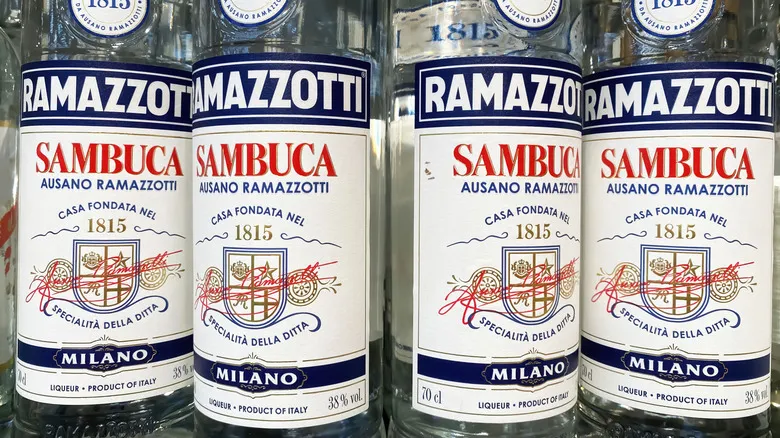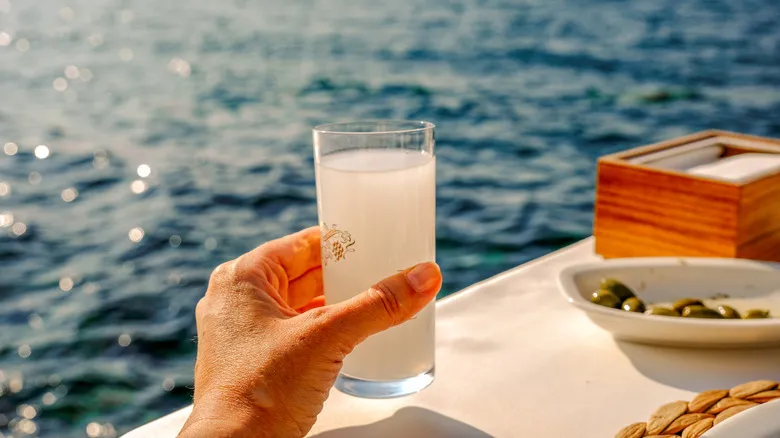What is sambuca?

Originating from Italy, sambuca is a liqueur with a distinct anise flavor, characterized by its rich sweetness and herbal notes. Although it appears clear in the bottle, it delivers a notably intense taste. The primary flavor comes from either star anise or green anise seeds, enhanced by a variety of spices such as cloves, fennel, cinnamon, coriander, elderflower, and dill extract. The overall flavor profile is predominantly licorice-like, with hints of spice and warmth in the background. With an alcohol content of 38% ABV, it also provides a noticeable kick.
Thanks to the presence of anise oil, sambuca becomes cloudy when mixed, a feature that can add an appealing color to cocktails. Its thick consistency allows for versatile use in mixed drinks, similar to other liqueurs. Consequently, sambuca is enjoyed in various ways: on its own, paired with coffee (which it complements beautifully), or served neat and chilled.
What is ouzo?

Bold and herbal, yet easy to sip, ouzo is the cherished anise-flavored spirit of Greece and Cyprus. Its base for distillation is grape pomace, a byproduct of winemaking, which also sets grappa apart from other brandies. In this liquor, the combination of fruity and spicy flavors creates a drink that is both refreshing and potent. Instead of being consumed quickly, it is meant to be savored over ice at the beginning of a meal.
The dominant flavor in ouzo comes from anise seeds, giving it a distinct licorice-like taste. The oils from these seeds are responsible for the louche effect, where the liquor turns a milky white when mixed with water. Additionally, various other flavors may be present, depending on the producer. Distillers often incorporate a wide range of spices, including cloves, cinnamon, cardamom, coriander, peppermint, and star anise. They may also use botanicals like angelica root, ginger, fennel, mint, and mastic, a tree resin.
Despite the potential for diverse flavorings, most ouzos share a relatively consistent taste profile. Anise, sweetness, and strong spirit notes dominate, with other herbal flavors providing balance. However, each ouzo distillery has its own secret blend of ingredients, resulting in subtle differences between bottles. The alcohol content can also vary, ranging from 37.5% to 45% ABV. Thus, while nearly all ouzos offer a similar experience, there are nuances to be discovered in the details.
European Union regulation controls both alcohols

The two types of spirits originate from different Mediterranean cultures, each governed by specific European Union regulations. Sambuca is associated with Italy but lacks geographic protection. Instead, it is subject to legal standards regarding its ingredients, such as the requirement for anise, a minimum of 350 milligrams of sugar per liter, and an alcohol by volume (ABV) of at least 38%, as specified in the Official Journal of the European Union published in 2008.
In contrast, ouzo production is restricted to Greece and Cyprus. This spirit benefits from two forms of regulatory protection. The first is the Protected Designation of Origin, which identifies specific regions where ouzo can be produced. Additionally, the Protected Geographical Indication further safeguards the name by preventing the sale of other spirits labeled as ouzo.
The regulations governing ouzo are managed by Greek law rather than European Union law. According to the Greek Federation of Spirit Producers, ouzo must have a minimum ABV of 37.5%, be distilled in copper stills with a capacity of less than 1,000 liters, and contain no more than 50 grams of sugar per liter. Ouzo also features various substyles, which vary based on the initial pomace, flavorings added, and distillation methods. The European Union recognizes geographic indications for specific ouzo-producing regions, including Macedonia, Thrace, and others.
The two drinks are consumed in different ways

As a classic Greek beverage, ouzo is associated with a specific way of being enjoyed. It is typically served in a tall glass known as a kanoakia, often with a splash of ice to dilute it and bring out its characteristic cloudy appearance. Ouzo is primarily sipped as an apéritif, accompanying a variety of meze such as grilled octopus, dolma, and fried saganaki cheese. The anise and alcoholic notes of ouzo pair beautifully with these dishes, making it uncommon to mix it with other ingredients. While some may combine its anise flavor with lemon and mint, ouzo is not typically used in cocktails.
Similarly, sambuca is often enjoyed neat and is also served over ice to create a cloudy effect. Unlike ouzo, sambuca is typically consumed after a meal, often paired with dessert and shots of espresso. Its compatibility with coffee is highlighted in a ritual known as sambuca con la mosca, which involves adding several coffee beans to the glass.
Additionally, sambuca is featured in a variety of delightful Italian-inspired cocktails. With its liqueur-like characteristics, sambuca blends well with numerous spirits, making it a versatile addition to any bar cart. Its anise-forward flavor can mimic absinthe in a Sazerac, albeit with a lower alcohol content. The flavor profile also harmonizes with fruity notes, complementing everything from vibrant syrups to rum. Moreover, sambuca's sweetness can enhance desserts, providing a boozy twist to items ranging from fresh fruit to milkshakes.
Recommended

The Elevated Spin Geoffrey Zakarian Puts On His Holiday Martinis

The Secret To The Absolute Smoothest No-Churn Ice Cream Is In Your Liquor Cabinet

Give Your Old Fashioned A Smoky Makeover With One Simple Swap

What Is Oyster Vodka And How Do You Mix It Into Martinis?
Next up





